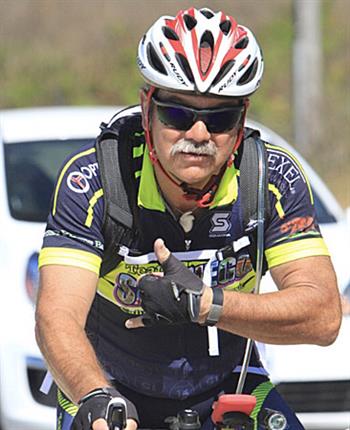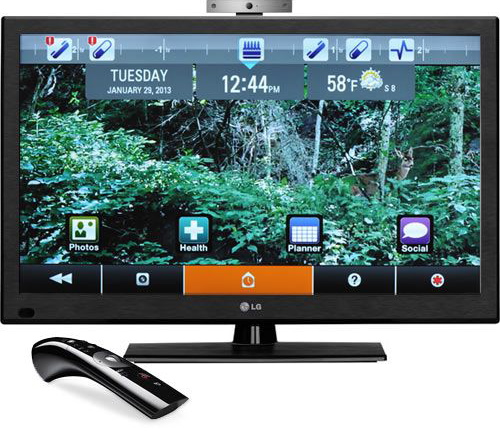Daily Business Report — June 23, 2014
UC San Diego Leads Statewide
Initiative to Map the Brain
The California budget signed by Gov. Jerry Brown creates a statewide research grants program called Cal-BRAIN, an initiative led by UC San Diego. With an initial allocation of $2 million, Cal-BRAIN — short for California Blueprint for Research to Advance Innovations in Neuroscience — is a state complement to the federal BRAIN Initiative announced by President Barack Obama in April 2013. It aims to “accelerate the development of brain mapping techniques, including the development of new technologies.”
According to a report put out by the university, UC San Diego played a significant role in the national initiative and will now lead the state effort to revolutionize our understanding of the brain and the diagnosis and treatment of brain disorders of all kinds. “By improving our ability to see what goes on in the brain in much greater detail and at a much faster timescale, we aim to make discoveries around autism, Alzheimer’s, PTSD and other behavioral health issues and injuries that affect everyone from our children to our homeless veterans,” the report said.
In this leadership role, UC San Diego will guide the collaboration among the UC campuses and is currently discussing a significant financial investment of non-state, university resources in Cal-BRAIN.
Ralph Greenspan, director of UC San Diego’s Center for Brain Activity Mapping, established at the university in May 2013, is coauthor with Paul Alivisatos, director of the Lawrence Berkeley National Laboratory, of a proposal to the University of California Office of the President and to the state Legislature that served as a blueprint for the bill just signed into law.
Said Chancellor Pradeep Khosla,: “We will be developing the next technology cluster in ‘neurotech’ just as we did in high-tech, clean-tech and more, creating high paying jobs and world renowned results. I am confident that, with our strengths in neuroscience and biotechnology in San Diego, we will be producing ground-breaking research with significant social impacts.”
Sorrento Mesa Office Buildings Sold for $40.2 Million

Office buildings in Sorrento Mesa that are home to a diverse range of businesses have been sold for $40.2 million by TA Associates Realty. The buyer is a partnership between DRA Advisors LLC and Cypress Office Properties LLC. The properties total 190,154 square feet and are fully leased.
The buildings are:
• 5910 Pacific Center, a three-story building with 50,882 square feet.
• Pacific Heights Plaza, a two-story, 51,261-square-foot building at 9985 Pacific Heights Boulevard.
• Sorrento Heights, a two-building project totaling 88,011 square feet at 10020 and 9980 Huennekens St.
DRA and Cypress plan to upgrade the common areas of each building.
Major tenants in the buildings include Harte-Hanks Intelligence Inc., Solera Wireless and Tearlab Corp. in Sorrento Heights; Charlotte Russe, Inc., in Pacific Center; and Raytheon Company and DPR Construction in Pacific Heights Plaza.
Cassidy Turley in San Diego office represented the seller and buyer.
Mr. A’s Building Gets a Facelift
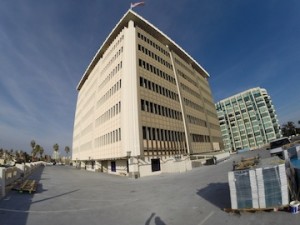

The building housing the famous Mr. A’s restaurant has a new face, thanks to a $1.1 million exterior skin refurbishment project done by Nautilus General Contractors.
The refurbishment was necessary because of faulty “aesthetic modernization” work done on the building in 2002, according to Stacey DiMeglio of Nautilus General.
The purpose of the work was to modify the building’s color scheme. The color of the exterior panels was changed. “As recommended by the architect, the existing sunscreen panels and mullions were painted, using an epoxy primer and urethane enamel,” said DiMeglio. “Since that time, the paint on the panels and mullions has continued to peel and fail, to the point it has created a significant aesthetic problem and a continued, increasing maintenance problem. It has been opined that the existing panels should never have been painted, as the porcelain enameled surface is too dense and smooth to accept and hold paint.”
The Nautilus project was to remove the paint and restore the sunscreen and panels to their original condition, as existed at the time of original construction, by physically removing the paint from the porcelain enameled steel panels.
When completed, the ceramic panels looked as they did when the building was built in the 1960s.
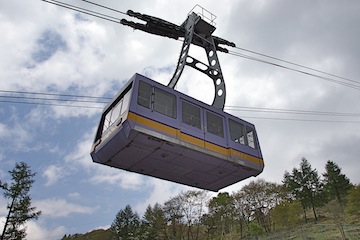
Ron Roberts Floats Air Tram Proposal
Would operate between Downtown and Balboa Park
A gondola to sweep through the air between Downtown San Diego and Balboa Park has been proposed by County Supervisor Ron Roberts. In an interview with the U-T San Diego, Roberts floated the lofty idea of an aerial tram. The paper reported that Roberts is expected to win unanimous approval from the county Board of Supervisors Tuesday to spend $75,000 to hire a consultant to study the project.
“I’ve only got four years left to do good things and I’ve been harboring this for quite some time,” Roberts told the paper. “I figured that instead of just visualizing it, let’s do a feasibility study.”
Roberts’ proposal calls for SANDAG to manage the study, which he said should take two or three months to complete. The $75,000 request will come from Neighborhood Reinvestment Program money to fund the study that will look at logistics of building an aerial gondola and how much the project might cost.
Roberts told the paper that he has spoken privately with representatives of several Downtown groups and received a positive response from all. One
scenario would have a Downtown terminus at the trolley station between Fifth and Sixth avenues. The Balboa Park stop, roughly two miles away, would be somewhere near the Spreckels Organ Pavilion. The elevated gondola cars would carry multiple, paying passengers.
“The whole thing is in the very embryonic stage, but I’m excited about it,” said Roberts.
— City News Service
Heart and Vascular Center Topped Out

Topping out ceremonies were held last week at the site of Sharp Grossmont Hospital’s new Heart and Vascular Center, a more than $60 million project under construction in La Mesa. A 220-foot crane hoisted the final steel beam up to the highest point of the building, marking the completion of the steel erection phase by McCarthy Building Companies Inc.
The Heart and Vascular Center will offer three levels specifically designed to treat the challenges of heart and vascular diseases and conditions, officials said. It will be adjacent to the hospital’s current operating rooms and cardiac cath labs. New square footage will total 71,000-square-feet, with an additional 17,000 planned for renovation of older areas of the hospital. Plans also call for four new hybrid operating rooms, four new cath labs, a pharmacy and clinical laboratory, as well as supply services space and a new loading dock.
The new center is one component of an overall master site plan that includes multiple construction improvement projects going forward. Officials said that when the three-story building is completed in spring 2015, it will greatly enhance the hospital’s ability and capacity to treat acute care patients and help decrease the high cardiovascular disease mortality rate in East County. with the best and most advanced care available in the community.

Elephant Bar Closes in Rancho Bernardo
The Costa Mesa-based parent company of the Elephant Bar casual dining chain has filed for bankruptcy and is closing 16 restaurants nationwide, including the Elephant Bar at 17051 Rancho Bernardo Road in Rancho Bernardo.
S.B. Restaurant Co. announced the Chapter 11 filing along with a motion for approval of $3.3 million of “debtor-in-possession” financing, which will allow the company to continue to operate in the ordinary course of business during the bankruptcy proceeding, according to a statement.
Elephant Bar executives — who say they eventually intend to sell the chain — blamed the “challenging economic environment and increasing competitiveness of the industry” for the company’s financial woes.
BIO Convention Draws Early Crowds
An international biotech convention that will bring 15,000 executives and scientists, and former Secretary of State Hillary Clinton, got under way over the weekend in Downtown San Diego. The 2014 BIO International Convention officially begins today at the San Diego Convention Center, but workshops prior to the main gathering were held on the weekend at the Marriott Marquis and Marina.
Clinton, a possible candidate for the Democratic nomination for president, will speak to the group on Wednesday. Prior to her convention speech, she will appear at Warwich’s bookstore in La Jolla to promote her new book, “Hard Choices.” British entrepreneur Sir Richard Branson will speak on Tuesday.
The San Diego biotech sector will be well-represented, with 76 local biotechnology and pharmaceutical executives, scientists and innovators scheduled to speak on emerging trends in genomics, wireless healthcare, new research technologies and personalized medicine.
“The San Diego biotech industry is one of the top three regional clusters in the nation, and its importance is evidenced by the large number of local experts participating in the Convention program,” said Scott Whitaker, president of the BIO International Convention. “BIO 2014 also features our first Digital Health Zone, which recognizes an emerging field pioneered in San Diego.”
The conference also will feature an “innovation zone” sponsored by the National Institutes of Health and the National Science Foundation showcasing biotech startup companies, and a convention floor with more than 1,700 exhibitors, including 57 from the San Diego region.
A welcoming reception is scheduled for tonight aboard the USS Midway Museum.
Taxpayers Association Appoints New President and CEO
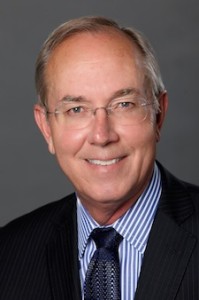
Telecommunications executive W. Mark Leslie has been selected as the new president and CEO of the San Diego County Taxpayers Association. Leslie takes over for Interim President and CEO Sean Karafin, who took the reins when former president and CEO Felipe Monroig became a deputy chief of Staff for Mayor Kevin Faulconer.
Leslie, 61, has been active in numerous civic and philanthropic efforts in San Diego, having most recently served as board chairman of the San Diego Regional Chamber of Commerce (in 2012) and United Way of San Diego (in 2010-11).
Prior to retiring from AT&T in 2012, Leslie served as vice president of external affairs — Southern California. He also served as chairman of the AT&T California State PAC.
After heading membership and finance committees for the San Diego Regional Chamber of Commerce, Leslie took over as board chairman two years ago. He currently serves as chair of the chamber’s Political Action Committee.
Neurologist Heads S.D. County Medical Society
Scripps Clinic neurologist J. Steven Poceta has been sworn in as the 129th president of the San Diego County Medical Society. Poceta was elected to the role for a one-year term by the organization’s nearly 3,000 physician members.
Poceta is a neurologist and sleep medicine specialist at Scripps Clinic Torrey Pines with a focus on neurologic sleep disorders such as restless leg syndrome, sleep walking and narcolepsy. He also diagnoses and treats general neurologic conditions such as insomnia and headache.
UC San Diego Selects Arts and Humanities Dean

Cristina Della Coletta, a professor of Italian and an associate dean at the University of Virginia, has been appointed dean of the Division of Arts and Humanities at the UC San Diego, effective Aug. 15.
Della Coletta is currently serving as associate dean of humanities and the arts in the College and Graduate School of Arts and Sciences at the University of Virginia, where she has been a faculty member since 1992. She has served as director of the undergraduate program in Italian and associate chair of the Department of Spanish, Italian, and Portuguese, in addition to holding a number of other academic leadership roles within the college and university.
Della Coletta has been the recipient of numerous teaching awards and fellowships. And for the past decade, she has volunteered as a senior mentor to junior faculty in two UVA programs, one focused on excellence in diversity and the other on teaching.
She is also an award-winning author of three books, with research interests that include contemporary Italian literature, particularly historical fiction, film and cultural studies, women’s studies, and the use of technology in the humanities.

The World’s Smartest Surfers
San Diegans are good at a lot of things, and surfing will always be up there on the list. But we’re not just any old surfers. We’re the world’s smartest surfers, according to an article that looks at UC San Diego’s surf team in the Wall St. Journal. Past members of the team are doctors, NASA engineers, physicists and surfboard entrepreneurs. The message: In San Diego, you don’t have to sacrifice a top-notch education for waves and quality of life.
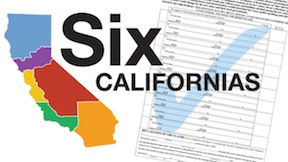
Supporters of Initiative to Split California
Into Six States Start Gathering Signatures
Backers of an initiative that would divide California into six states gathered signatures at 143 locations throughout the state Saturday and Sunday in an attempt to put the measure on the November 2016 ballot.
California has grown ungovernable — be it Arnold Schwarzenegger or Jerry Brown as governor — (and) the problems we face are far too ingrained to be fixed in Sacramento,” Anna Morris of Six Californias told City News Service. “We need to reboot and the Six Californias initiative would bring government much closer to the people.”
Venture capitalist Tim Draper said he wrote the initiative because he “wanted people to have a choice, to be local to their state government and to be able to get a refresh so that schools, streets and waterways could improve, poverty would decrease and businesses would want to keep jobs here.”
Joe Rodota, a co-founder of OneCalifornia, a committee opposing the initiative, said “it has negative implications that could cost California’s businesses and taxpayers tens of billions of dollars.”
Rodota estimated the cost of documenting and dividing the assets and liabilities of California into six pieces would cost billions of dollars and take decades. “That would be the greatest single misuse of time and money in the history of California,” said Rodota, a cabinet secretary under former Gov. Pete Wilson.
Proposed Initiative:
If voters approve the Six Californias initiative and Congress agrees to admit five new states, West California would consist of Los Angeles, Ventura, Santa Barbara and San Luis Obispo counties.
South California would consist of Orange, Riverside, San Diego, San Bernardino and Imperial counties.
The eight coastal and adjacent counties from Monterey County to San Francisco would form Silicon Valley.
The 14 inland counties from Kern to San Joaquin, Calaveras and Alpine would form Central California.
The 13 counties from the Pacific Ocean to the Nevada border from Marin and Sonoma counties to Sierra, Nevada, Placer and El Dorado counties would form North California.
The state’s 14 northernmost counties would form the state of Jefferson, taking the name from the proposed state under a short-lived 1941 effort that would have combined California’s Del Norte, Siskiyou and Modoc counties with four in Oregon.
(County voters could approve reassignment to a different new state if the second state approves.)
The initiative’s backers need to submit valid signatures from 807,615 registered voters — 8 percent of the total votes cast for governor in the 2010 general election — by July 18 to qualify the measure for the November 2016 ballot, according to the Secretary of State’s Office.
— City News Service
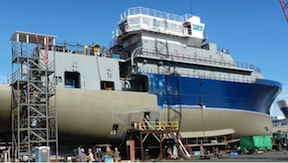
Defense Department Funds Five Scripps Ocean Research Projects
The Defense Department announced awards to five researchers ast Scripps Institution of Oceanography for projects that will help scientists characterize waves, improve ocean weather and climate prediction, and analyze acoustics in the deep ocean.
The Defense University Research Instrumentation Program grants support the development of instruments that have a wide range of military applications. The awards continue a history of collaboration between Scripps and the Navy that dates back to the years immediately prior to World War II, when the Navy would charter Scripps’ sole research vessel.
The latest awards went to these researchers:
• Marine acoustics researcher Bill Hodgkiss will design and fabricate a two-dimensional, 256-element hydrophone array for use in the collection of mid-frequency ambient noise and underwater acoustic propagation data in deep water.
• Bruce Appelgate will install a scientific radar that makes precise real-time measurements of surface waves around the research vessel Sally Ride, which is currently under construction.
• Researcher Eric Terrill received funds to support the Global Wave Buoy Array. The array will be comprised of small, expendable drifter buoys equipped with GPS technology that measures the height, period, and direction of ocean waves and reports these data back to Scripps via satellite.
• Oceanographer Andrew Lucas received funds to develop the real-time telemetry capabilities of the Wirewalker wave-powered profiler. The Wirewalker traverses a vertical wire suspended beneath a surface float, propelled by the energy in ocean-surface waves. This system can profile a variety of ocean phenomena indefinitely.
• Physical oceanographer Rob Pinkel received funds to significantly upgrade an existing Hydrographic Doppler Sonar System mounted on the hull of Scripps research vessel Roger Revelle.
— Times of San Diego


